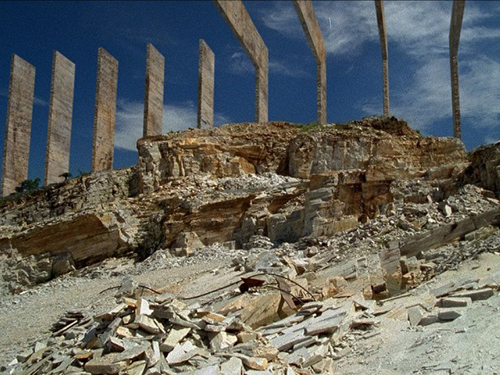
A voyage into the far west of Brazil leads us to a monumental structure - petrified at the centre of the savannah. Inspired by the epic construction of the city of Brasília, the film uses this history to imagine it otherwise. Through the geological traces that lead us to this monument, the film unearths a history of exploration, prophecy and myth.
“A Idade da Pedra is a journey to the past and to the future. And in the same time, we are in front of a reinterpretation of the landscape and history. The artist Ana Vaz rethinks the birth of the city of Brasilia showing the Brazilian central plateau, a huge and arid territory known as sertão. We observe its geological foundations, the light of the sunrise, the shadows and color specters on the stone. We also observe an unexpected apparition. Something inexplicable and definitive. The artist makes use of the history to imagine it in another way and enlighten a story of exploration, prophecy and myth. The territory is scanned with the camera: its spaces, presences, living beings. In that moment is when the architecture becomes present in the landscape, when the time disappears, when the History is rewritten in the screen. As spectators, we don’t know if everything is happening from the distant future or from the primitive past. A Idade da Pedra is a hypothesis. An artefact that puts the ideals and believes of the Modernism in doubt.”
Tabakalera
“Ana Vaz’s A Idade da Pedra departs from a vision so steady that only the sound of singing birds attests the passing of time. It consists of the image of the sun rising in a prairie, its light gradually dissipating the shadows of dawn and slowly bathing all that the eyes can see in a rich spectrum of colours. The film takes place in the central plateau of Brazil, the sertão, an arid and vast plain dotted with scrub. Its Portuguese meaning is untranslatable, not only because the sertão stands for an endemic landscape that is a space as physical as mental, but also because the term sertão sounds as ser-tão [be-much], containing in itself all the superlative possibilities of being: ser-tão, to be much, to exceed the inherent ontology of the self. The naturecultural characteristics of this territory are scanned in a profusion of detailed and intense portraits of spaces, animals and people that reveal Vaz’s unique exploratory gaze. This landscape and its dwellers are the set for the artist to rethink the birth of the city of Brasília and its geological foundations, opening itself to a journey that becomes an intense moment of discovery of a hypothetical future as well as an occasion to reflect about the ideals and beliefs of modernism.”
Filipa Ramos1
- 1Filipa Ramos, “Extended Programme Notes For The Screening Programme: A Idade da Pedra (Ana Vaz, 2013) / La Région Centrale (Michael Snow, 1971), Birkbeck Cinema, 14 November 2015,” (Originally published in Lux, 16 November, 2015).

